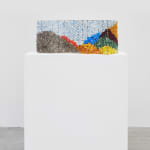-
Artworks





Bab Al-Zuhur (Gate of Flowers), 2023
Hand-flamed Glass Beads, Steel, Wire12 x 29 x 7 in
30.5 x 73.7 x 17.8 cm
Pedestal 35 (l) x 12 (w) x 42 (h) inchesSoldFurther images
In a series of new sculptures, Nassar utilizes traditional glass-working techniques made famous in Hebron, a Palestinian city in the southern West Bank. These intricate landscapes are made by wiring...In a series of new sculptures, Nassar utilizes traditional glass-working techniques made famous in Hebron, a Palestinian city in the southern West Bank. These intricate landscapes are made by wiring thousands of handmade glass beads—most of which he flame-worked himself—onto custom-built steel frames. The original object that inspired these sculptures is a traditional sconce, wherein glass beads are individually placed within a steel frame and held together by copper-coated aluminum wiring. The works are both an homage to the tradition of glass making and a contemporary envisioning of the medium as it applies to Nassar’s practice. Each bead is a solid piece of glass, flame-worked by glass artisans in the United States and Nassar himself, who learned and mastered the technique. The beads are devised from pre-selected colored glass rods, which are melted down and shaped into individual beads, some are translucent and others serve as blocks of solid color. Each sculpture requires thousands of beads hand-placed by Jordan within steel frames.
The sculptures are named for the gates of the Old City in Jerusalem, their forms are modeled on sections of the ancient walls. In “Bab Al-Zuhur (Gate of Flowers)”, sloping red and earth-toned hills cascade across the zig-zagging metal frame which houses the beads. Much like Nassar’s embroideries, these landscapes follow a grid pattern that is mapped out in advance. The varied opacities of differently colored beads allow Nassar to create moments of transparency that transform a solid wall into an entry point. He likens these works to portals in which the structure becomes a site for the projection of imagination, rather than simply an obscuring or delineation of the landscape. At the same time, they evoke the long tradition of screens and transparencies in domestic spaces of pan-Arab architecture.Exhibitions
Jordan Nassar, "I Cut The Sky In Two", 291 Grand Street, James Cohan, New York, October 23- Nov 21, 2020
Jordan Nassar, "The Field Is Infinite," KMAC Museum, Louisville, Kentucky, December 5, 2020 - April 4, 2021









